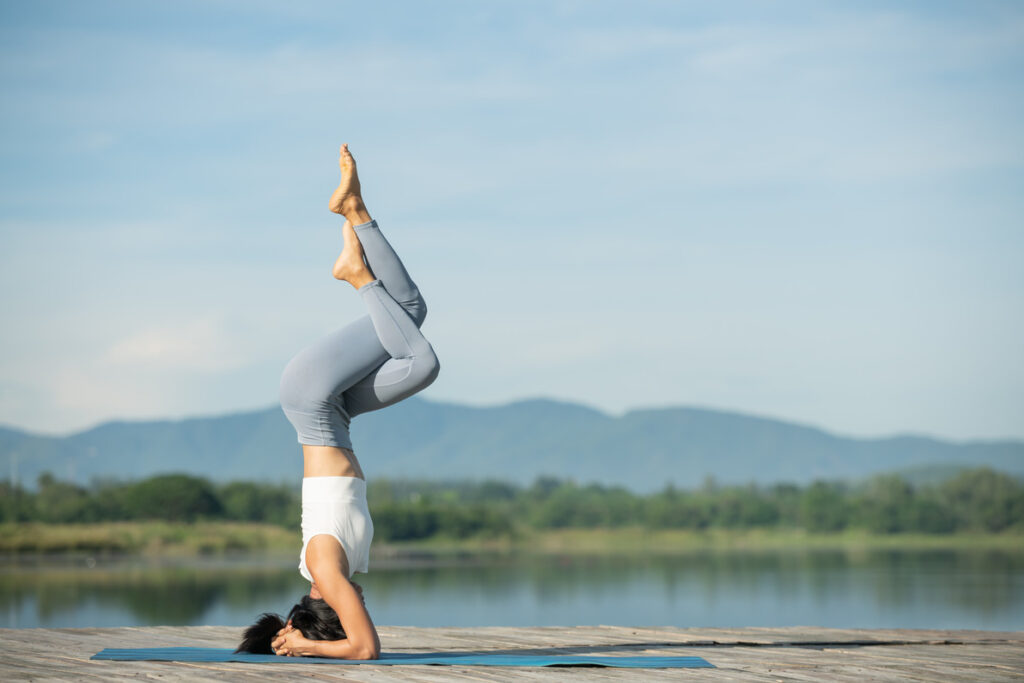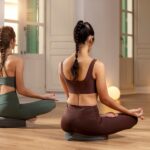Bhujangasana is a back-bending posture that resembles the cobra with a raised head. This is a posture that is used multiple times in the Surya Namaskar series. It is back bending that helps the heart to open up and face the world. This posture makes one bold, as they are stimulating to expand the heart and encourage inhalation along with embracing life.
How to do Cobra Pose?
- Lie flat on the abdomen in a pronated position
- Place palms beside the chest
- Stabilise the lower back by tucking the tailbone down and engaging the core
- With an inhale, looking at naval life the chest forward and up till the belly comes off the floor
- Make sure the hips are still on the mat
- In the end lift the head looking straight at the nose (Nasagrai Drishti)
- Move the shoulder away from each other and the elbows can be slightly bent
- Make sure that the upper back strength is used the most to lift up and not the arm strength
- Stay here for 10-12 counts
- With exhale slowly go all the way down to the mat with forehead touching the mat
- Repeat this for 3-4 rounds
Variations in Cobra pose
- Twisted cobra: As the cobra pose works on relaxing the abdominal muscles, the twisted cobra will help to stretch either side of the abdominals (especially the obliques). You can come into a cobra pose and twist your spine towards one side and look at the back of the legs. Stay here for some time and then twist towards the other side
- Active Cobra: One can challenge this posture by making it more active for the upper back muscles. In the supine position, take the palms off the mat and try to lift the chest up purely using the upper back muscles, stay here for 10-15 counts and keep lifting the upper back with every count.
- Dynamic: You can also make it active plus dynamic if this needs to be incorporated as a warm-up for back bends. Taking the palms off the mat, lift up and come back down. Repeat this for a couple of rounds to fee the upper back
Benefits of Cobra Pose
- Help cure lower back issues: In some cases of lower back issues where the forward bend is challenged, this posture can help release the tension from the lower back. However, consult the therapist or physician before choosing to do this during backache
- Keeps the spine healthy and supple: A healthy spine shows the health of an individual as it interferes with all nervous impulses connecting the brain to the body. This posture improves blood circulation to the back region, stimulating the nerves and improving this mind-body connection.
- Helps to relax the abdominal muscles: As this is a back bend, it helps to give a deep stretch to the abdominal muscles and also helps to stimulate the reproductive organs like ovaries and uterus thereby reducing any menstrual or other reproductive disorders.
- Adrenal glands functioning: As this also massages the adrenal glands situated at the top of the kidneys,
- Opens the chest area: As during the regular daily activities, we are either seated working on a desktop or laptop or continuously looking at the mobile which leads to minor kyphosis. Doing regular practice like cobra pose will help to reduce this symptom as it will help to relax the front muscles
- Strengthens the upper back muscles: As this backbend is more from the upper back, it helps to activate the upper back muscles to train them for some deep back bend exercise
Common mistakes and precautions
- Position of the Elbows: Make sure that the elbows are facing back and not to either side. Palms should be placed beside the chest under the shoulders so that even if the elbows are straightened, all three joints (shoulder, elbow and wrist) fall in one line.
- Try to put less pressure on arms: As this is a back bending and not arm strengthening exercise, putting all pressure on arms will reduce the benefit. Try to use your palms to just give minor support and let the back bend happen majorly from the back muscles.
- Stabilise the lower back: This is a heart-opening posture and the heart is situated in the thoracic area and not in the lower back. So stabilize the lower back by tucking the tailbone down before getting moving into the posture from a pronated position. This will save your lower back from any extra compression.
- Neck should be neutral: The neck or cervical spine should not be extended but it should be neutral
- Precautions: This posture should be avoided by a pregnant woman, someone who has gone through any abdominal surgery or has any kind of injury in the wrist and carpel tunnel syndrome
- Counter Pose: This should be followed by a good counter pose like a seated forward fold or child’s pose to relax the back muscles
If you wish to improve your back bends do join us for Yoga teacher training course in Bali and explore your body’s capabilities to beyond the comfort zone.


